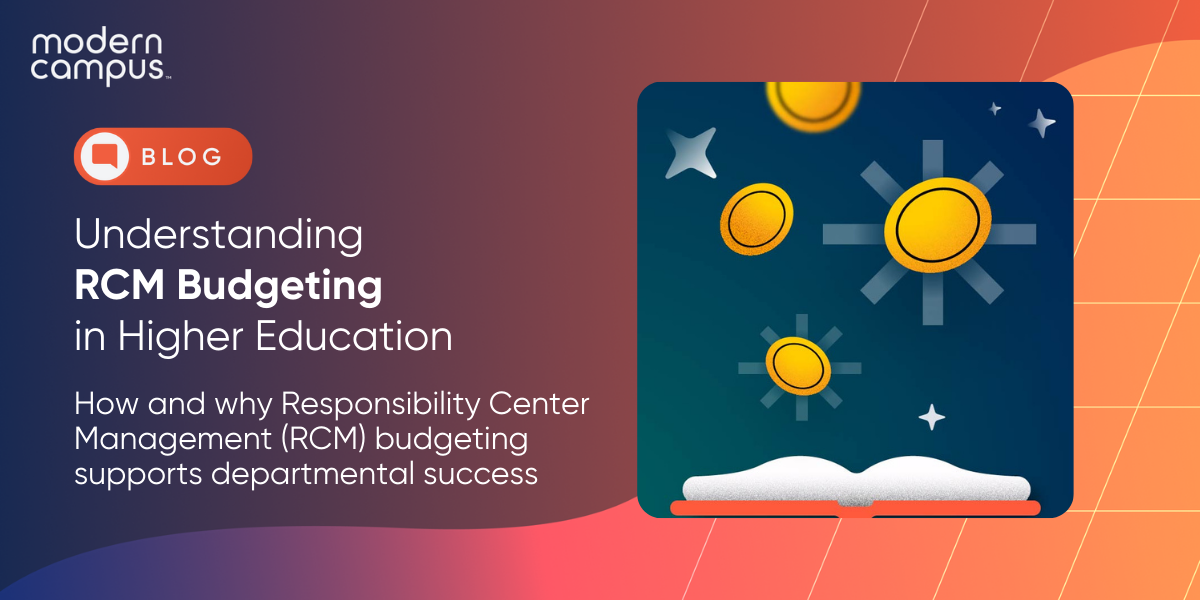Understanding RCM Budgeting in Higher Education
The faculty and staff who interact most often with students naturally possess valuable insights into students’ needs. Yet, at most institutions, budgeting decisions are exclusively made at the top level.
This traditional higher education finance structure grapples with the challenge of effectively allocating resources without input from those directly involved in the day-to-day departmental operations.
This gap can pose significant obstacles year-round, especially whenever quick adjustments are vital to a department’s goals and opportunities. Responsibility Center Management (RCM) budgeting offers a solution by flipping this approach on its head.
By decentralizing budgeting authority to individual units, RCM empowers colleges and universities to tap into the expertise of faculty and staff on the ground. This bottom-up approach enables institutions to align resources more closely with their strategic objectives, fostering a more responsive and agile financial framework.
Understanding RCM Budgeting in Higher Education
RCM budgeting changes how universities handle money by letting individual units have more say in their budget allocation. Instead of central administration deciding where funds go, each unit manages its own.
This includes generating funds, spending it and dealing with extra or missing budgetary lines. Department heads, deans and central administrators work together to create budget rules, divide up resources and make sure money is used responsibly.
This way, financial goals are tied to institutional priorities, encouraging units to find new ways to make money while being efficient and creative.
Benefits of RCM Budgeting in Higher Education
RCM budgeting has the potential to make institutions more financially resilient and flexible. It does this by matching resources with priorities and revenue streams. This approach allows universities to respond swiftly to changes and put money where it's most needed—whether that involves creating new programs to meet student demands or supporting faculty research.
Increased Financial Transparency and Accountability Measures
By allocating financial resources based on specific responsibilities and revenue-generating capabilities, RCM ensures that budgetary decisions are directly tied to the roles of each department or unit. This clarity in strategic resource management makes it easier to track how funds are leveraged and whether they align with organizational goals.
With department heads or managers responsible for managing their allocated budgets, there's a clear line of accountability for financial performance. These financial transparency and accountability measures streamline financial oversight while also encouraging efficient resource allocation across the organization.
Incentivizing Efficiency and Innovation
By giving individual units and departments control over their budgets, RCM encourages departments to be mindful of their spending while pursuing their missions.
This autonomy empowers leaders to make strategic decisions tailored to their needs, pushing them to find creative solutions to challenges within their budgetary constraints. As a result, departments are motivated to streamline processes, find cost-effective solutions and explore new approaches.
Empowering decision-making at the departmental level
RCM budgeting gives department leaders more control over their money, motivating them to take ownership and be accountable. RCM lets departments customize their budgets to fit their goals, encouraging them to be flexible and come up with new ideas. With this decentralized approach, leaders can spend money on teaching, research and helping students in ways that work best for them.
Best Practices for a Successful Implementation
Implementing a robust RCM budgeting model may present challenges, but institutions that have adopted this framework have identified some best practices to ease the transition. These practices serve as valuable guidelines, offering clarity on resource allocation, establishing accountability systems and guiding strategic decision-making.
Engage Stakeholders Early and Often
You should engage stakeholders from the get-go and keep them involved throughout the process. This means involving faculty members, administrative staff and student representatives right from the start to ensure diverse viewpoints are considered, fostering a sense of ownership and buy-in.
By gathering input early on, you can address any concerns upfront and tailor your budgeting model to fit the specific needs and goals of your institution.
Ongoing communication and collaboration with stakeholders are also key, as they help maintain transparency and build trust.
Provide adequate training and support
Recognizing the learning curve involved, be sure to provide comprehensive training sessions tailored to the diverse needs of your faculty and staff. Offering ongoing support through workshops, accessible resources and expert guidance nurtures confidence and competence in navigating the intricacies of the RCM model.
This commitment to empowerment not only equips individuals with the necessary skills but also fosters a culture of collaboration and innovation essential for long-term success.
Continuously monitor and adapt the model
By maintaining a vigilant watch, you can promptly identify any emerging challenges or opportunities, thereby ensuring the model's ongoing relevance and utility. Incorporating feedback from all stakeholders, conducting thorough analyses and benchmarking against industry standards enables informed adjustments to optimize resource allocation.
Embracing a mindset of flexibility and readiness for change enhances financial management while fortifying the school's resilience in navigating unforeseen circumstances.
Shifting to the RCM Model
Every higher education institution has distinct missions, programs and priorities. Responsibility Center Management (RCM) budgeting acknowledges and celebrates this diversity by giving every department a say in how its budget is allocated and resources are leveraged.
With budget planning control decentralized, RCM allows departments to customize their financial approaches to meet their unique needs and objectives. It's about recognizing that one size doesn't fit all and empowering each department to chart its financial course effectively.
By embracing RCM, you’ll ensure fiscal responsibility and promote institutional effectiveness while fostering a culture of collaboration, innovation and excellence.
Last updated: June 1, 2024




